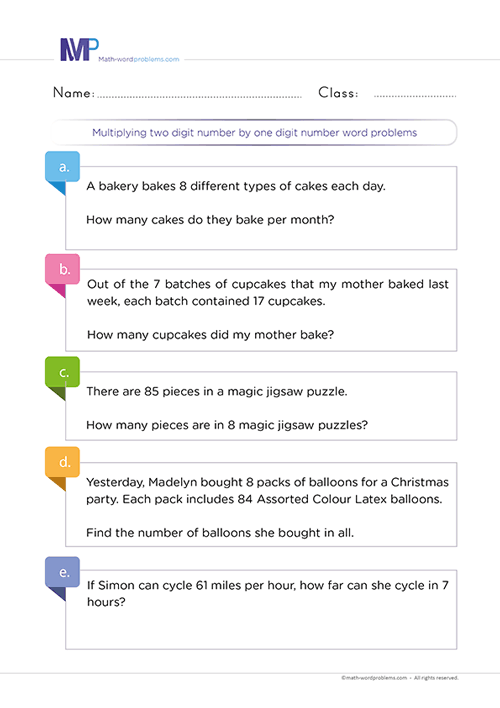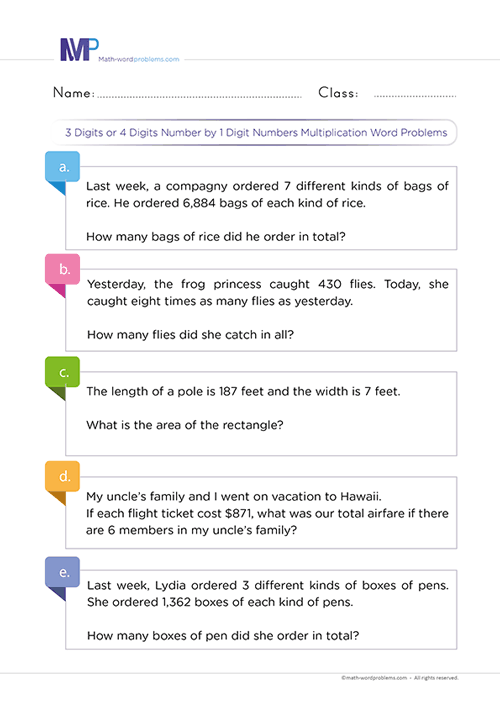 How do you multiply two-digit numbers by one-digit number word problems?
How do you multiply two-digit numbers by one-digit number word problems?
Regarding how do you multiply two-digit numbers by one-digit number word problems, here is a unique resource with short and straightforward solving steps. To further enable 4th graders to overcome difficulties when multiplying two-digit numbers by one-digit number word problems, we will instruct them on the strategies and principles of reading and understanding problems before solving them.
This with constant practice of this resource, your kids' general reasoning skills will be at work whenever they encounter complex multiplication word problems.
The best and simple steps to solve multiplication of two-digit numbers by one-digit numbers word problems
Below you will find the best and simple steps to solve multiplication of two-digit numbers by one-digit numbers word problems. These captivating steps cover all word problems, from a simple verbal description of the basic mathematical operations to advanced modeling problems.
These steps will encourage young learners to solve more functional and real-world problems on multiplication effectively. Hence, they will not only stick to their usual routine thinking but also think out of the box whenever they encounter complex real-world multiplication word problems.
We will also include some challenging yet fun examples with steps to multiply two-digit numbers by one-digit number word problems.
Step 1: IDENTIFY THE PROBLEM
To identify the problem, you must read the word problem very carefully to know what the problem wants you to solve by looking for important numbers and keywords in the word problem.
For instance, If you come across one of the following keywords in a word problem: - times, multiplied by, product, product of, factor, of, multiply, times, multiple, double, triple, groups, by, twice, area, equal groups, every, in all, total, increased by, as much, each, lots of, groups of, per, etc., then it implies that you have to perform a Multiplication Operation.
- ***
Note: One key Element for learners to understand is that they should not always rely on keywords alone. That is to say; the same keyword can have different meanings in different word problems.
For this reason, we reiterate on the importance of reading the question very carefully to understand the situation that the word problem is describing, then figure out exactly which operation to use
Step 2: STRATEGIZE OR GATHER RELEVANT INFORMATION
How will you solve or tackle the problem?
Always remember that each word problem may require a different format. Hence, the key points below will enable young math learners to tackle any format however it comes.
- As mentioned in step 1 above, from the keyword(s) in the word problem, you can determine if you need to perform a Multiplication Operation.
- But it would be best if you do not depend only on keywords. Also, try to understand the situation that the problem is describing.
- Now, after knowing the operation you will perform, construct short sentences to represent the given word problem.
Step 3: CREATE THE EQUATION
Moving on to this step, we will write a numerical equation representing the information in the word problem.
Step 4: PROVIDE A SOLUTION
From step 3 above, multiply the numbers using regrouping or other multiplication methods like long multiplication, grid multiplication, or lattice to determine the final result. Always recall adding the unit of measurement to the final result.
Step 5: CHECK YOUR WORK
Finally, check if your answer makes sense. For instance, estimate the answer and see if it is close to what you expected. However, if the answer is not what you expected, go back to step one and start all over again.
Examples on how to multiply by one digit numbers word problems
Example one
Step 1:After carefully reading the problems, you’ll realize that the important numbers are 72 and 6. As you read further, the keywords that you’ll find in the problem are “each” and “in all.”
Step 2:So, how will you tackle the problem? As you can see, the keyword alone is not enough to know the operation that you will perform. Hence, you need to reread the problem to better understand what the problem is trying to say. After doing this, you’ll realize that the word problem requires a multiplication operation.
Next, after knowing which operation you will perform, form short sentences to represent the given word problem.
- Number of balloons that Abigail bought for a Christmas party = 6.
- Number of balloons in each pack = 72.
- Therefore, the number of balloons she bought in all = the number of balloons in each pack × the number of balloons that Abigail bought for a Christmas party.
Step 3:Here, write down a numerical equation to represent the bolded sentence in step 2 above to solve this word problem:
72 × 6 = ?
Step 4: From step 3 above, multiply the numbers using regrouping or other multiplication methods like long multiplication, grid multiplication, and lattice to determine the result. Always include the unit of measurement in your final answer.
Using the long multiplication method, we have
So, she bought 432 balloons in all
Step 5: Finally, check if your answer makes sense. For instance, estimate the answer and see if it is close to what you expected. However, if the answer is not what you expected, go back to step one and start all over again.
Example Two
Step 1: The important numbers here are 9 and 30 (per month). Also, the most important keyword(s) found in the word problem is “per.”
Step 2: Now, how are you going to tackle the problem? Also, from the situation that the problem is describing and the keyword(s) found in the word problem calls for you to perform a multiplication operation.
Next, after knowing the operation you are going to perform, form short sentences to represent the given word problem.
- Number of different types of cakes the bakery bake each day = 9
- Number of days in a month = 30
- Therefore, the number of cakes they bake per month = the number of days in a month × the number of different types of cakes the bakery bakes each day.
Step 3:Write down a numerical equation to represent the first bolded statement in step 2 above to be able to solve this word problem:
30 × 9 = ?
Step 4:From step 3 above, multiply the numbers using regrouping or any other multiplication methods like long multiplication, grid multiplication, and lattice method to determine the result. Always recall adding the unit of measurement to your final answer.
Using the long multiplication method, we have
So, they bake 270 cakes per month
Step 5: Finally, check if your answer makes sense. For instance, estimate the answer and see if it is close to what you expected. However, if the answer is not what you expected, go back to step one and start all over again.





